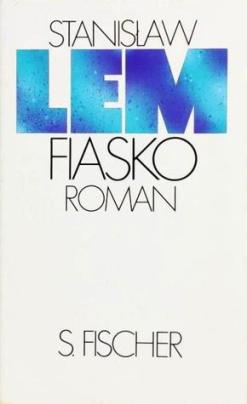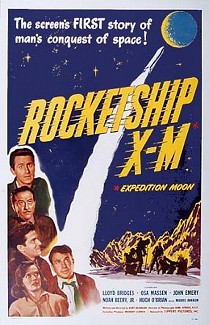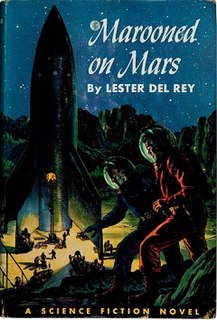
Fiasco is a science fiction novel by Polish author Stanisław Lem, first published in a German translation in 1986. The book, published in Poland the following year and translated into English by Michael Kandel in the same year, is a further elaboration of Lem's skepticism: in Lem's opinion, the difficulty in communication with extraterrestrial intelligence is more likely cultural disparity rather than spatial distance. It was nominated for the Arthur C. Clarke Award.

Stanley Grauman Weinbaum was an American science fiction writer. His first story, "A Martian Odyssey", was published to great acclaim in July 1934; the alien Tweel was arguably the first character to satisfy John W. Campbell's challenge: "Write me a creature who thinks as well as a man, or better than a man, but not like a man." Weinbaum wrote more short stories and a few novels, but died from lung cancer less than a year and a half later.

Earthlight is a science fiction novel by British writer Arthur C. Clarke, published in 1955. It is an expansion to novel length of a novella of the same name that he had published four years earlier.

Rocketship X-M is a 1950 American black-and-white science fiction film from Lippert Pictures, the first outer space adventure of the post-World War II era. The film was produced and directed by Kurt Neumann and stars Lloyd Bridges, Osa Massen, John Emery, Noah Beery Jr., Hugh O'Brian, and Morris Ankrum.

Men Into Space is an American black-and-white science fiction television series, produced by Ziv Television Programs, Inc., that was first broadcast by CBS from September 30, 1959 to September 7, 1960. The series depicts future efforts by the United States Air Force to explore and develop outer space. The series' star, William Lundigan, played Col. Edward McCauley.

Jupiter, the largest planet in the Solar System, has appeared in works of fiction across several centuries. The way the planet has been depicted has evolved as more has become known about its composition; it was initially portrayed as being entirely solid, later as having a high-pressure atmosphere with a solid surface underneath, and finally as being entirely gaseous. It was a popular setting during the pulp era of science fiction. Life on the planet has variously been depicted as identical to humans, larger versions of humans, and non-human. Non-human life on Jupiter has been portrayed as primitive in some works and more advanced than humans in others.
"The Callistan Menace" is a science fiction short story by American writer Isaac Asimov. It first appeared in the April 1940 issue of Astonishing Stories and was reprinted in the 1972 collection The Early Asimov. It was the second science fiction story written by Asimov, and the oldest story of his still in existence.

Imperial Moon is a BBC Books original novel written by Christopher Bulis and based on the long-running British science fiction television series Doctor Who. It features the Fifth Doctor, Turlough, and Kamelion.

"A Martian Odyssey" is a science fiction short story by American writer Stanley G. Weinbaum originally published in the July 1934 issue of Wonder Stories. It was Weinbaum's second published story, and remains his best known. It was followed four months later by a sequel, "Valley of Dreams". These are the only stories by Weinbaum set on Mars.
"The Planet of Doubt" is a science fiction short story by American writer Stanley G. Weinbaum that was first published in the October 1935 issue of Astounding Stories. It is Weinbaum's third story featuring Hamilton Hammond and Patricia Burlingame, a sequel to "Parasite Planet" and "The Lotus Eaters".
"The Mad Moon" is a science fiction short story by American writer Stanley G. Weinbaum, first published in the December 1935 issue of Astounding Stories. As did his earlier stories "A Martian Odyssey" and "Parasite Planet", "The Mad Moon" emphasizes Weinbaum's alien ecologies. "The Mad Moon" was the only Weinbaum story set on Io.

"The Red Peri" is a science fiction novella by American writer Stanley G. Weinbaum, which first appeared in the November 1935 issue of Astounding Stories. Sam Moskowitz has noted that Weinbaum planned to write a series of sequels to "The Red Peri" but died before he could do so. "The Red Peri" is the only Weinbaum story set on Pluto. The novel also inspired Arthur C. Clarke, who stated that David Bowman's helmetless spacewalk in 2001: A Space Odyssey was inspired by Frank Keene's escape from the pirate base in "The Red Peri".

The Purple Monster Strikes is a 1945 Republic Movie serial. It was also released as a Century 66 television film under the title D-Day on Mars (1966).

Flight to Mars is a 1951 American Cinecolor science fiction film drama, produced by Walter Mirisch for Monogram Pictures, directed by Lesley Selander, that stars Marguerite Chapman, Cameron Mitchell, and Arthur Franz.
The Planetary series of stories by Stanley G. Weinbaum is a series of short stories, published in Wonder Stories and Astounding Stories in the 1930s, which are set upon various planets and moons of the Solar System.

Moon of Mutiny is a juvenile Science fiction novel by author Lester del Rey published in 1961 by Holt, Rinehart & Winston as the final part of the Jim Stanley Series. The story takes place mostly on the Moon following the adventures of the main character Fred Halpern after he is expelled from Goddard Space Academy for insubordination, and tries to find his way back into space.

Spacehounds of IPC is a science fiction novel by American writer E. E. Smith. It was first published in book form in 1947 by Fantasy Press in an edition of 2,008 copies. It was the first book published by Fantasy Press. The novel was originally serialized in the August, September and October issues of the magazine Amazing Stories in 1931. Smith was disenchanted when he saw editor T. O'Conor Sloane's unauthorized changes in the story, most likely made to give equal length to each of the three parts it had been split into.

DARLAH is a 2008 young adult science fiction/horror novel by Norwegian author Johan Harstad. The book was originally published in Norway on September 15, 2008 by Cappelen Damm, with an English language translation being published by Little, Brown in New York City on July 10, 2012. Rights to DARLAH have also been sold to sixteen other countries: Denmark, Sweden, Finland, Iceland, Faroe Islands, France, the Netherlands, Germany, UK, Turkey, Bangladesh, Vietnam, Taiwan, South Korea, Mexico and Brazil. In 2008 Harstad's work on DARLAH won him a Brage Prize.

Marooned on Mars is a juvenile science fiction novel written by American writer Lester del Rey. It was published by John C. Winston Co. in 1952 with illustrations by Alex Schomburg.

Canal Zone is a 1942 American aviation adventure film starring Chester Morris and Forrest Tucker. The action takes place in the Panama Canal Zone and revolves around aviators in an out-of-the-way air base flying U.S. Army bombers.
















